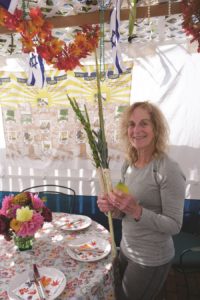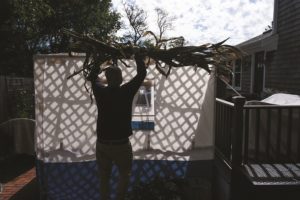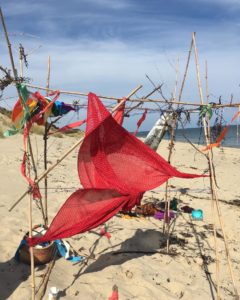With the sun shining brightly after last week’s rainy spell, Anita Young and Alan Burack of Eastham began gathering pieces of the sukkah they build every autumn. The tent-like structure they are setting up on their patio is where they will eat their meals during Sukkot, the week-long Jewish harvest festival, which this year runs from Oct. 9 to 16.

The Biblical account of the holiday commands observant Jews to live in these dwellings during the festival as a way to remember the Israelites’ long sojourn in the desert after they fled slavery in Egypt in search of the promised land.
“We’re putting it up to keep the tradition alive,” says Young. “In Israel and in New York, people have them on balconies, so why not have one in Eastham?”
Their commitment to keeping this tradition is a bit more involved than, say, setting up a Christmas tree. Young and Burack piece together steel bars to create the armature of an 8-by-10-foot structure, which they then cover with a white and blue fabric. Traditionally, the ceiling of the structure must allow those inside to see the stars. In Israel, palm leaves are typically strewn across the top of the sukkah. Young and Burack opt for a more New England solution: cornhusks over strips of lattice.
Young grew up in a Jewish family in Mattapan but didn’t celebrate Sukkot until later in life. That’s when friends helped her “form and find my own Jewishness and the importance of tradition,” she says. When their children were young, she adds, putting up a sukkah was a way to hand on meaning, but it was also fun. She still finds a place for playful details in the sukkah, hanging beads from the ceiling amidst fluttering Israeli flags.

“For me, it’s a connection,” says Young. “It connects me to Israel. It’s a connection to what came before and what should come after.” It also serves as a connection between holidays, with Sukkot closely following Rosh Hashanah and Yom Kippur. “You go from one holiday to another,” says Young.
“This one is a way to celebrate what we get from the earth and to be grateful for every single thing we have,” she says.
A sukkah is by definition temporary. “We always build an impromptu sukkah near our house,” says Harriet Korim of Wellfleet. “Last year, we did a construction at Newcomb Hollow with bamboo and cloth and a chair we borrowed from the dump.
“I love the idea of Sukkot shalom, which harkens back to this idea of Abraham’s tent, open to everyone,” says Korim, referring to Abraham’s desert dwelling place, described as one that welcomed wanderers.

“It’s a mitzvah,” says Young — a good deed, that is — to invite people into your sukkah. She takes care to clear the area around her sukkah to make way for a friend who will be visiting in a wheelchair. “You’re also inviting the patriarchs and matriarchs,” says Young, who has a yellow and white cloth hanging in the center of the sukkah with the names of important Biblical figures written in Hebrew.
“You can invite whoever you want,” says Korim, who maintains a decidedly less traditional approach to the holiday. Korim’s Sukkot celebrations include inspirational texts from a range of spiritual sources, she says, and she draws a connection between the holiday and the pagan precursors to Halloween, which welcomed spirits.
“Make your own,” says Korim, who has no set construction plans for this year’s sukkah. Even Young’s and Burack’s well-constructed sukkah once blew over in a storm. Toward the end of this year’s setup, Young stands back to assess the progress.
“It doesn’t need to be perfect,” she says. “That’s part of the point.”
